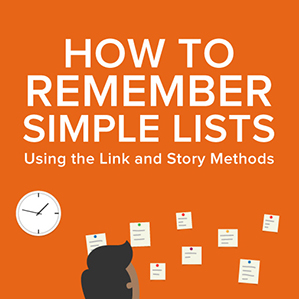The Link and Story Methods
Remembering a Simple List

© Veer
Pakhnyushchyy Vitaliy
Use your imagination to help you remember.
It's useful to be able to learn a list. Maybe you have some important tasks to complete, facts to recall for an exam, or key points to include in a speech. If you can make a list, and remember it, you'll be more organized, confident and effective.
And the good news is that there are some tried-and-true ways to boost your chances of success.
This article explains two such techniques: the Link Method and the Story Method. Both of these centuries-old strategies will help you to learn lists quickly and easily – using the power of imagination to maximize your memory.
What Are the Link and Story Methods?
The Link Method is one of the easiest "mnemonics," or memory tools, to learn. You choose interesting images to represent items on a list, then link those images together in memorable ways. Each link jogs your memory about what comes next.
Start with the first thing on your list. Choose an image for it, then link it to the next item – perhaps by imagining the two things smashing together, or by visualizing one on top of the other. Then move on through the list, linking each item with the next.
The Story Method takes this a step further – by using a story to connect all the items on the list. The flow of the story and the strength of the images help you to recall the original information.
Invent a story that features each item on your list, in the right order. Make your story funny, strange and exciting, and you'll find that it's even easier to remember.
Using the Link and Story Methods
Both of these methods rely on images. Sometimes the original information will suggest very clear images – a list of items to buy at the grocery store, for example. At other times, particularly when you're learning more abstract concepts, you’ll need to design your own "image clues" to trigger the memories.
Tip:
If a word on your list doesn't trigger images, use a word that looks or sounds similar to it. That should still jog your memory about the original word.
For example, let's say you wanted to learn the list of the seven largest countries in the world: Russia, Canada, U.S., China, Brazil, Australia, India.
You could do this with either the Link Method or the Story Method, as follows:
- Link Method – Choose a memorable image for each country, then link the first to the second, the second to the third, and so on.
Perhaps you imagine opening a set of Russian dolls (Russia) to find a Canada goose (Canada) inside! The goose lands on the lawn of the White House (U.S.). The door of the White House opens to reveal beautiful china plates and bowls laid out for a banquet (China). On each plate you can see a pile of Brazil nuts (Brazil). You collect up the nuts and use them to build a model of the Sydney Opera House (Australia). Finally, on the curved roof of the Opera House, you balance a tray of spicy Indian food (India).
- Story Method – Construct the images into a story, giving you more opportunities to add emotional triggers, and helping to make the information "flow."
Maybe a large Russian bear (Russia) is eating maple syrup (Canada) at the top of the Empire State Building (U.S.). But suddenly he drops the china bowl he's using (China). It lands on a member of the Brazilian soccer team (Brazil) playing a match in the street below. The player retaliates by hurling a boomerang (Australia) at the bear – who decides to run off and hide… in the famous Taj Mahal palace (India).
Note:
Mnemonics like these are even more effective when you choose your own images and links. Try to visualize and organize the information in ways that are particularly meaningful and memorable to you.
Tip:
When you need to learn larger or more complex sets of information, consider using a mnemonic method called the Journey Technique.
Link and Story Methods Infographic
Click on the thumbnail image below to see the Link and Story Methods represented as an infographic:
Key Points
The Link Method is an age-old memory technique for remembering lists. It works by turning information into vivid images, then linking those images together in memorable ways.
The Story Method is similar. It also relies on images, but this time the images are connected together as an engaging and memorable story.
This site teaches you the skills you need for a happy and successful career; and this is just one of many tools and resources that you'll find here at Mind Tools. Subscribe to our free newsletter, or join the Mind Tools Club and really supercharge your career!







Applying the link and story method takes practice. Keeping the links and the story simple helps to increase the flow.
Thank you for your comment.
Michele
Mind Tools Team